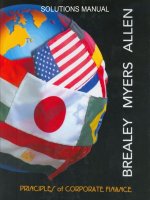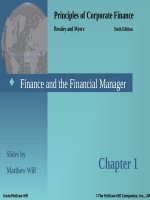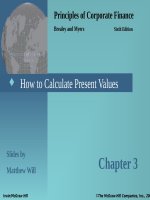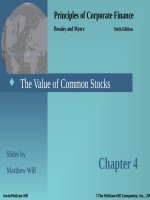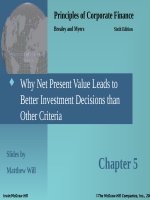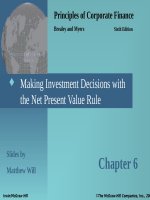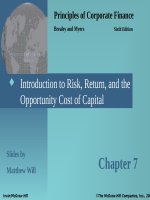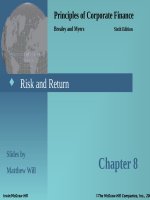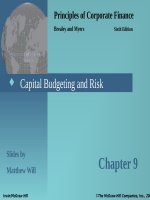principles of corporate finance 7ed brealey myers solutions manual
Bạn đang xem bản rút gọn của tài liệu. Xem và tải ngay bản đầy đủ của tài liệu tại đây (1.33 MB, 339 trang )
SOLUTIONS MANUAL
CHAPTER 2
Present Value and the Opportunity Cost of Capital
Answers to Practice Questions
1.
Let INV = investment required at time t = 0 (i.e., INV = -C0) and let x = rate of
return. Then x is defined as:
x = (C1 – INV)/INV
Therefore:
C1 = INV(1 + x)
It follows that:
NPV = C0 + {C1/(1 + r)}
NPV = -INV + {[INV(1 + x)]/(1 + r)}
NPV = INV {[(1 + x)/(1 + r)] – 1}
a.
When x equals r, then:
[(1 + x)/(1 +r)] – 1 = 0
and NPV is zero.
b.
When x exceeds r, then:
[(1 + x)/(1 + r)] – 1 > 0
and NPV is positive.
2.
The face value of the treasury security is $1,000. If this security earns 5%, then
in one year we will receive $1,050. Thus:
NPV = C0 + [C1/(1 + r)] = -1000 + (1050/1.05) = 0
This is not a surprising result, because 5 percent is the opportunity cost of
capital, i.e., 5 percent is the return available in the capital market. If any
investment earns a rate of return equal to the opportunity cost of capital, the NPV
of that investment is zero.
1
3.
NPV = -$1,300,000 + ($1,500,000/1.10) = +$63,636
Since the NPV is positive, you would construct the motel.
Alternatively, we can compute r as follows:
r = ($1,500,000/$1,300,000) – 1 = 0.1538 = 15.38%
Since the rate of return is greater than the cost of capital, you would construct the
motel.
4.
NPV
Investment
5.
Return
18,000 − 10,000
= 0.80 = 80.0%
10,000
1)
− 10,000 +
2)
− 5,000 +
9,000
= $2,500
1.20
9,000 − 5,000
= 0.80 = 80.0%
5,000
3)
− 5,000 +
5,700
= −$250
1.20
5,700 − 5,000
= 0.14 = 14.0%
5,000
4)
− 2,000 +
4,000
= $1,333.33
1.20
4,000 − 2,000
= 1.00 = 100.0%
2,000
18,000
= $5,000
1.20
a.
Investment 1, because it has the highest NPV.
b.
Investment 1, because it maximizes shareholders’ wealth.
a.
NPV = (-50,000 + 30,000) + (30,000/1.07) = $8,037.38
b.
NPV = (-50,000 + 30,000) + (30,000/1.10) = $7,272.73
Since, in each case, the NPV is higher than the NPV of the office building
($7,143), accept E. Coli’s offer. You can also think of it another way. The true
opportunity cost of the land is what you could sell it for, i.e., $58,037 (or
$57,273). At that price, the office building has a negative NPV.
6.
The opportunity cost of capital is the return earned by investing in the best
alternative investment. This return will not be realized if the investment under
consideration is undertaken. Thus, the two investments must earn at least the
same return. This return rate is the discount rate used in the net present value
calculation.
2
7.
a.
NPV = -$2,000,000 + [$2,000,000 × 1.05)]/(1.05) = $0
b.
NPV = -$900,000 + [$900,000 × 1.07]/(1.10) = -$24,545.45
The correct discount rate is 10% because this is the appropriate rate for an
investment with the level of risk inherent in Norman’s nephew’s restaurant. The
NPV is negative because Norman will not earn enough to compensate for the
risk.
c.
NPV = -$2,000,000 + [$2,000,000 × 1.12]/(1.12) = $0
d.
NPV = -$1,000,000 + ($1,100,000/1.12) = -$17,857.14
Norman should invest in either the risk-free government securities or the risky
stock market, depending on his tolerance for risk. Correctly priced securities
always have an NPV = 0.
8.
a.
Expected rate of return on project =
$2,100,000 − $ 2,000,000
= 0.05 = 5.0%
$2,000,000
This is equal to the return on the government securities.
b.
Expected rate of return on project =
$963,000 − $ 900,000
= 0.07 = 7.0%
$900,000
This is less than the correct 10% rate of return for restaurants with similar
risk.
c.
Expected rate of return on project =
$2,240,000 − $2,000,000
= 0.12 = 12.0%
$2,000,000
This is equal to the rate of return in the stock market.
d.
Expected rate of return on project =
$1,100,000 − $1,000,000
= 0.10 = 10.0%
$1,000,000
This is less than the return in the equally risky stock market.
3
9.
⎡ $1,100,000 + ($1,600,00 0 × 1.12) ⎤
NPV = −$2,600,000 + ⎢
⎥ = −$17,857.14
1.12
⎣
⎦
The rate at which Norman can borrow does not reflect the opportunity cost of the
investments. Norman is still investing $1,000,000 at 10% while the opportunity
cost of capital is 12%.
10.
a.
This is incorrect. The cost of capital is an opportunity cost; it is the rate of
return foregone on the next best alternative investment of equal risk.
b.
Net present value is not “just theory.” An asset’s net present value is the
net gain to investors who acquire the asset. The concept of “maximizing
profits” is the fuzzy concept here. For example, this goal does not make it
clear whether it is appropriate to try to increase profits today if it means
sacrificing profits tomorrow. In contrast to the objective of maximizing
profits, the net present value criterion correctly accounts for the timing of
returns from an investment.
Note that “maximize profits” is an unsatisfactory objective in other respects
as well. It does not take risk in to account, so that it is not possible to
determine whether it is worth trying to increase (average) profits if, in the
process, risk is also increased. It is also unclear which accounting figure
should be maximized because the profit figure depends on the accounting
methods chosen. It is cash flow that is important, not accounting profit.
Cash flow can be spent or invested, while accounting profit is a number on
a piece of paper which can change with changes in accounting methods.
c.
The comment can be interpreted in two ways:
1.
The manager may try to boost stock price temporarily by
disseminating a deceptively rosy picture of the firm’s prospects. This
possibility is not considered in this chapter. However, it is difficult to
imagine how a manager can act in the stockholders’ best interests by
deceiving them.
2.
The manager may sacrifice present value in order to achieve the
“gently rising trend.” This is not in the stockholders’ best interests. If
they want a gently rising trend of wealth or income, they can always
achieve it by shifting wealth through time (i.e., by borrowing or
lending). The firm helps its stockholders most by making them as
rich as possible now.
4
11.
The investment’s positive NPV will be reflected in the price of Airbus common
stock. In order to derive a cash flow from her investment that will allow her to
spend more today, Ms. Smith can sell some of her shares at the higher price or
she can borrow against the increased value of her holdings.
12.
Dollars Next Year
220,000
216,000
203,704
200,000
a.
Dollars Now
Let x = the amount that Casper should invest now. Then ($200,000 – x) is
the amount he will consume now, and (1.08 x) is the amount he will
consume next year.
Since Casper wants to consume exactly the same amount each period:
200,000 – x = 1.08 x
Solving, we find that x = $96,153.85 so that Casper should invest
$96,153.85 now, he should spend ($200,000 - $96,153.85) = $103,846.15
now and he should spend (1.08 × $96,153.85) = $103,846.15 next year.
b.
Since Casper can invest $200,000 at 10% risk-free, he can consume as
much as ($200,000 × 1.10) = $220,000 next year. The present value of
this $220,000 is: ($220,000/1.08) = $203,703.70, so that Casper can
consume as much as $203,703.70 now by first investing $200,000 at 10%
and then borrowing, at the 8% rate, against the $220,000 available next
year. If we use the $203,703.70 as the available consumption now, and
again let x = the amount that Casper should invest now, we can then solve
the following for x:
$203,703.70 – x = 1.08 x
x = $97,934.47
5
Therefore, Casper should invest $97,934.47 now at 8%, he should spend
($203,703.70 – $97,934.47) = $105,769.23 now, and he should spend
($97,934.47 × 1.08) = $105,769.23 next year. [Note that this approach
leads to the result that Casper borrows $203,703.70 at 8% and then
invests $97,934.47 at 8%. We could simply say that he should borrow
($203,703.70 - $97,934.47) = $105,769.23 at 8% against the $220,000
available next year. This is the amount that he will consume now.]
c.
The NPV of the opportunity in (b) is: ($203,703.70 - $200,000) = $3,703.70
13.
“Well functioning” means investors all have free and equal access to competitive
capital markets. Maximizing value may not be in all shareholders’ interest if
different shareholders are taxed at different rates, or if they do not or can not
receive important information at the same time (due to differences in costs or
abilities), or if they have different access to the capital markets.
14.
If a firm does not have a reputation for honesty and fair business practices, then
customers, suppliers, and investors will not want to do business with the firm.
The firm, by acting in such a fashion, will not be able to maximize the value of the
firm and shareholders will start to sell and the stock price will fall. The further the
stock price falls, the easier it is for another group of investors to buy control of the
firm and to replace the old management team with one that is more responsive to
its stockholders.
6
Challenge Questions
1.
The two points raised in the question do not invalidate the NPV rule.
a.
As long as capital markets do their job, all members of the community,
wealthy or poor, have the same rate of time preference, because they all
adjust to the same borrowing-lending line. The government acts in the
best interests of all of its citizens by choosing only investments having
positive NPV when discounted at the market interest rate.
b.
The “longer horizon” argument, to the extent it is valid, requires a lower
discount rate. It does not require discarding the NPV concept. But should
the government ever use a lower discount rate? Note that the rate of
return on incremental real investment in the private sector equals the
market rate of interest. Why should the government divert resources into
public investments offering a lower rate of return? Lowering the discount
rate for public investment means allowing the government to invest
resources at a lower rate of return. That would not help future
generations.
There are some cases where a lower discount rate might be justified,
however. For example, NPV analysis might indicate that a wilderness
mountain meadow should be torn up in order to create a copper mine, but
We the People might decide to make it a national park instead. In part,
this decision reflects the difficulty of capturing intangible benefits of the
park in an NPV calculation. Even if the intangibles could be expressed as
dollar values, there is a case for discounting at a relatively low rate:
People’s time preferences for wilderness recreation may not fully adjust to
capital market rates of return.
2.
a.
1 + r = 5/4 so that r = 0.25 = 25 percent
b.
$2.6 million – $1.6 million = $1 million
c.
$3 million
d.
Return = (3 – 1)/1 = 2.0 = 200 percent
e.
Marginal rate of return = rate of interest = 25 percent
f.
PV = $4 million – $1.6 million = $2.4 million
g.
NPV = -$1.0 million + $2.4 million = $1.4 million
h.
$4 million ($2.6 million cash + NPV)
i.
$1 million
j.
$3.75 million
7
3.
a-d.
See Figure 2.1a on page 10.
e.
NPV = C0 + C1/(1 + r)
$2 million = -$6 million + C1/(1 + 0.10)
C1 = $8.8 million
f.
The marginal rate of return equals the interest rate, 10 percent.
g.
After the firm has announced its investment plans, the firm’s PV is equal to
the amount of cash initially available ($10 million) plus the PV of the
investment ($2 million). Thus, the firm’s PV after the announcement is
$12 million.
h.
After the company pays out $4 million, the shareholders have $4 million in
cash plus shares worth $8 million. (We know the shares are worth
$8 million because the PV of their total investment is $12 million.) In order
to spend as they desire, they must borrow $2 million. The interest rate is
10 percent.
i.
Next year, they will have the cash flow at t = 1, which is $8.8 million, but
they will also have to repay the loan (plus interest, of course):
$8.8 million – ($2 million × 1.1) = $6.6 million
4.
a.
Expected cash flow = ($8 million + $12 million + $16 million)/3 = $12 million
b.
Expected rate of return = ($12 million/$8 million) – 1 = 0.50 = 50%
c.
Expected cash flow = ($8 + $12 + $16)/3 = $12
Expected rate of return = ($12/$10) – 1 = 0.20 = 20%
The net cash flow from selling the tanker load is the same as the payoff
from one million shares of Stock Z in each state of the world economy.
Therefore, the risk of each of these cash flows is the same.
d.
NPV = -$8,000,000 + ($12,000,000/1.20) = +$2,000,000
The project is a good investment because the NPV is positive. Investors
would be prepared to pay as much as $10,000,000 for the project, which
costs $8,000,000.
8
5.
a.
Expected cash flow (Project B) = ($4 million + $6 million + $8 million)/3
Expected cash flow (Project B) = $6 million
Expected cash flow (Project C) = ($5 million + $5.5 million + $6 million)/3
Expected cash flow (Project C) = $5.5 million
b.
Expected rate of return (Stock X) = ($110/$95.65) –1 = 0.15 = 15.0%
Expected rate of return (Stock Y) = ($44/$40) –1 = 0.10 = 10.0%
Expected rate of return (Stock Z) = ($12/$10) –1 = 0.20 = 20.0%
c.
Project B
Project C
Stock X
Stock Y
Stock Z
Percentage Differences
Slump v. Normal
Boom v. Normal
4/6 = 66.67%
8/6 = 133.33%
5/5.5 = 90.91%
6/5.5 = 109.09%
80/110 = 72.73% 140/110 = 127.27%
40/44 = 90.91%
48/44 = 109.09%
8/12 = 66.67%
16/12 = 133.33%
Project B has the same risk as Stock Z, so the cost of capital for Project B
is 20%. Project C has the same risk as Stock Y, so the cost of capital for
Project C is 10%.
d.
NPV (Project B) = -$5,000,000 + ($6,000,000/1.20) = 0
NPV (Project C) = -$5,000,000 + ($5,500,000/1.10) = 0
e.
The two projects will add nothing to the total market value of the
company’s shares.
9
Figure 2-1a
(Dollar amounts are in millions)
Dollars,
Time t=1
Firm’s cash
receipts at
t=1
8.80
•
Preferred consumption
pattern
•
6.60
Amount
consumed
at t=1
PV of shareholders’
investment
Firm’s
investment
4
6
Firm’s payout
at t=0
10
•
12
Amount consumed
today
10
Dollars,
Time t=0
CHAPTER 3
How to Calculate Present Values
Answers to Practice Questions
1.
a.
b.
c.
d.
PV = $100 × 0.905 = $90.50
PV = $100 × 0.295 = $29.50
PV = $100 × 0.035 = $ 3.50
PV = $100 × 0.893 = $89.30
PV = $100 × 0.797 = $79.70
PV = $100 × 0.712 = $71.20
PV = $89.30 + $79.70 + $71.20 = $240.20
a.
b.
c.
PV = $100 × 4.279 = $427.90
PV = $100 × 4.580 = $458.00
We can think of cash flows in this problem as being the difference
between two separate streams of cash flows. The first stream is $100 per
year received in years 1 through 12; the second is $100 per year paid in
years 1 through 2.
2.
The PV of $100 received in years 1 to 12 is:
PV = $100 × [Annuity factor, 12 time periods, 9%]
PV = $100 × [7.161] = $716.10
The PV of $100 paid in years 1 to 2 is:
PV = $100 × [Annuity factor, 2 time periods, 9%]
PV = $100 × [1.759] = $175.90
Therefore, the present value of $100 per year received in each of years 3
through 12 is: ($716.10 - $175.90) = $540.20. (Alternatively, we can think
of this as a 10-year annuity starting in year 3.)
11
3.
a.
DF1 =
1
= 0.88 ⇒ so that r1 = 0.136 = 13.6%
1+ r1
b.
DF2 =
1
1
=
= 0.82
2
(1 + r2 )
(1.105)2
c.
AF2 = DF1 + DF2 = 0.88 + 0.82 = 1.70
d.
PV of an annuity = C × [Annuity factor at r% for t years]
Here:
$24.49 = $10 × [AF3]
AF3 = 2.45
e.
AF3 = DF1 + DF2 + DF3 = AF2 + DF3
2.45 = 1.70 + DF3
DF3 = 0.75
4.
The present value of the 10-year stream of cash inflows is (using Appendix
Table 3): ($170,000 × 5.216) = $886,720
Thus:
NPV = -$800,000 + $886,720 = +$86,720
At the end of five years, the factory’s value will be the present value of the five
remaining $170,000 cash flows. Again using Appendix Table 3:
PV = 170,000 × 3.433 = $583,610
5.
a.
Let St = salary in year t
30
PV = ∑
t =1
30
St
20,000 (1.05)t −1 30 (20,000/1. 05) 30 19,048
=
=∑
=∑
∑
t
t
(1.08)t t −1
(1.08)t
t = 1 (1.08 / 1.05)
t −1 (1.029)
⎡ 1
⎤
1
= 19,048 × ⎢
−
= $378,222
30 ⎥
⎣ 0.029 (0.029) × (1.029) ⎦
b.
PV(salary) x 0.05 = $18,911.
Future value = $18,911 x (1.08)30 = $190,295
c.
Annual payment = initial value ÷ annuity factor
20-year annuity factor at 8 percent = 9.818
Annual payment = $190,295/9.818 = $19,382
12
6.
Period
0
1
2
3
7.
Discount
Factor
1.000
0.893
0.797
0.712
Cash Flow
Present Value
-400,000
-400,000
+100,000
+ 89,300
+200,000
+159,400
+300,000
+213,600
Total = NPV = $62,300
We can break this down into several different cash flows, such that the sum of
these separate cash flows is the total cash flow. Then, the sum of the present
values of the separate cash flows is the present value of the entire project. All
dollar figures are in millions.
Cost of the ship is $8 million
PV = -$8 million
Revenue is $5 million per year, operating expenses are $4 million. Thus,
operating cash flow is $1 million per year for 15 years.
PV = $1 million × [Annuity factor at 8%, t = 15] = $1 million × 8.559
PV = $8.559 million
Major refits cost $2 million each, and will occur at times t = 5 and t = 10.
PV = -$2 million × [Discount factor at 8%, t = 5]
PV = -$2 million × [Discount factor at 8%, t = 10]
PV = -$2 million × [0.681 + 0.463] = -$2.288 million
Sale for scrap brings in revenue of $1.5 million at t = 15.
PV = $1.5 million × [Discount factor at 8%, t = 15]
PV = $1.5 million × [0.315] = $0.473
Adding these present values gives the present value of the entire project:
PV = -$8 million + $8.559 million - $2.288 million + $0.473 million
PV = -$1.256 million
8.
a.
PV = $100,000
b.
PV = $180,000/1.125 = $102,137
c.
PV = $11,400/0.12 = $95,000
d.
PV = $19,000 × [Annuity factor, 12%, t = 10]
PV = $19,000 × 5.650 = $107,350
e.
PV = $6,500/(0.12 - 0.05) = $92,857
Prize (d) is the most valuable because it has the highest present value.
13
9.
a.
Present value per play is:
PV = 1,250/(1.07)2 = $1,091.80
This is a gain of 9.18 percent per trial. If x is the number of trials needed
to become a millionaire, then:
(1,000)(1.0918)x = 1,000,000
Simplifying and then using logarithms, we find:
(1.0918)x = 1,000
x (ln 1.0918) = ln 1000
x = 78.65
Thus the number of trials required is 79.
b.
(1 + r1) must be less than (1 + r2)2. Thus:
DF1 = 1/(1 + r1)
must be larger (closer to 1.0) than:
DF2 = 1/(1 + r2)2
10.
Mr. Basset is buying a security worth $20,000 now. That is its present value.
The unknown is the annual payment. Using the present value of an annuity
formula, we have:
PV = C × [Annuity factor, 8%, t = 12]
20,000 = C × 7.536
C = $2,654
11.
Assume the Turnips will put aside the same amount each year. One approach to
solving this problem is to find the present value of the cost of the boat and equate
that to the present value of the money saved. From this equation, we can solve
for the amount to be put aside each year.
PV(boat) = 20,000/(1.10)5 = $12,418
PV(savings) = Annual savings × [Annuity factor, 10%, t = 5]
PV(savings) = Annual savings × 3.791
Because PV(savings) must equal PV(boat):
Annual savings × 3.791 = $12,418
Annual savings = $3,276
14
Another approach is to find the value of the savings at the time the boat is
purchased. Because the amount in the savings account at the end of five years
must be the price of the boat, or $20,000, we can solve for the amount to be put
aside each year. If x is the amount to be put aside each year, then:
x(1.10)4 + x(1.10)3 + x(1.10)2 + x(1.10)1 + x = $20,000
x(1.464 + 1.331 + 1.210 + 1.10 + 1) = $20,000
x(6.105) = $20,000
x = $ 3,276
12.
The fact that Kangaroo Autos is offering “free credit” tells us what the cash
payments are; it does not change the fact that money has time value. A 10
percent annual rate of interest is equivalent to a monthly rate of 0.83 percent:
rmonthly = rannual /12 = 0.10/12 = 0.0083 = 0.83%
The present value of the payments to Kangaroo Autos is:
$1000 + $300 × [Annuity factor, 0.83%, t = 30]
Because this interest rate is not in our tables, we use the formula in the text to
find the annuity factor:
⎡ 1
⎤
1
$1,000 + $300 × ⎢
−
= $8,938
30 ⎥
⎣ 0.0083 (0.0083) × (1.0083) ⎦
A car from Turtle Motors costs $9,000 cash. Therefore, Kangaroo Autos offers
the better deal, i.e., the lower present value of cost.
15
13.
The NPVs are:
at 5 percent ⇒ NPV = −$150,000 −
$100,000 $300,000
+
= $26,871
1.05
(1.05)2
at 10 percent ⇒ NPV = −$150,000 −
$100,000 300,000
+
= $7,025
1.10
(1.10)2
at 15 percent ⇒ NPV = −$150,000 −
$100,000 300,000
+
= −$10,113
1.15
(1.15)2
The figure below shows that the project has zero NPV at about 12 percent.
As a check, NPV at 12 percent is:
NPV = −$150,000 −
$100,000 300,000
+
= −$128
1.12
(1.12)2
30
20
10
NPV
NPV
0
-10
-20
0.05
0.10
Rate of Interest
16
0.15
14.
a.
Future value = $100 + (15 × $10) = $250
b.
FV = $100 × (1.15)10 = $404.60
c.
Let x equal the number of years required for the investment to double at
15 percent. Then:
($100)(1.15)x = $200
Simplifying and then using logarithms, we find:
x (ln 1.15) = ln 2
x = 4.96
Therefore, it takes five years for money to double at 15% compound
interest. (We can also solve by using Appendix Table 2, and searching for
the factor in the 15 percent column that is closest to 2. This is 2.011, for
five years.)
15.
a.
This calls for the growing perpetuity formula with a negative growth rate
(g = -0.04):
PV =
b.
$2 million
$2 million
=
= $14.29 million
0.10 − ( −0.04)
0.14
The pipeline’s value at year 20 (i.e., at t = 20), assuming its cash flows last
forever, is:
PV20 =
C21
C (1 + g)20
= 1
r−g
r−g
With C1 = $2 million, g = -0.04, and r = 0.10:
PV20 =
($2 million) × (1 − 0.04)20 $0.884 million
=
= $6.314 million
0.14
0.14
Next, we convert this amount to PV today, and subtract it from the answer
to Part (a):
PV = $14.29 million −
$6.314 million
= $13.35 million
(1.10)20
17
16.
a.
This is the usual perpetuity, and hence:
PV =
b.
C $100
=
= $1,428.57
r
0.07
This is worth the PV of stream (a) plus the immediate payment of $100:
PV = $100 + $1,428.57 = $1,528.57
c.
The continuously compounded equivalent to a 7 percent annually
compounded rate is approximately 6.77 percent, because:
e0.0677 = 1.0700
Thus:
PV =
$100
C
=
= $1,477.10
r 0.0677
Note that the pattern of payments in part (b) is more valuable than the
pattern of payments in part (c). It is preferable to receive cash flows at the
start of every year than to spread the receipt of cash evenly over the year;
with the former pattern of payment, you receive the cash more quickly.
17.
a.
PV = $100,000/0.08 = $1,250,000
b.
PV = $100,000/(0.08 - 0.04) = $2,500,000
c.
⎡ 1
⎤
1
−
= $981,800
PV = $100,000 × ⎢
20 ⎥
⎣ 0.08 (0.08) × (1.08) ⎦
d.
The continuously compounded equivalent to an 8 percent annually
compounded rate is approximately 7.7 percent , because:
e0.0770 = 1.0800
Thus:
⎡ 1
⎤
1
−
= $1,020,284
PV = $100,000 × ⎢
(0.077)(20) ⎥
⎦
⎣ 0.077 (0.077) × e
(Alternatively, we could use Appendix Table 5 here.) This result is greater
than the answer in Part (c) because the endowment is now earning
interest during the entire year.
18
18.
To find the annual rate (r), we solve the following future value equation:
1,000 (1 + r)8 = 1,600
Solving algebraically, we find:
(1 + r)8 = 1.6
(1 + r) = (1.6)(1/8) = 1.0605
r = 0.0605 = 6.05%
The continuously compounded equivalent to a 6.05 percent annually
compounded rate is approximately 5.87 percent, because:
e0.0587 = 1.0605
19.
With annual compounding: FV = $100 × (1.15)20 = $1,637
With continuous compounding: FV = $100 × e(0.15)(20) = $2,009
20.
One way to approach this problem is to solve for the present value of:
(1)
$100 per year for 10 years, and
(2)
$100 per year in perpetuity, with the first cash flow at year 11
If this is a fair deal, these present values must be equal, and thus we can solve
for the interest rate, r.
The present value of $100 per year for 10 years is:
⎡1
⎤
1
PV = $100 × ⎢ −
10 ⎥
⎣ r (r) × (1 + r) ⎦
The present value, as of year 10, of $100 per year forever, with the first payment
in year 11, is:
PV10 = $100/r
At t = 0, the present value of PV10 is:
⎡ 1 ⎤ ⎡ $100 ⎤
×
PV = ⎢
⎥
10 ⎥ ⎢
⎣ (1 + r) ⎦ ⎣ r ⎦
Equating these two expressions for present value, we have:
⎡1
⎤ ⎡ 1 ⎤ ⎡ $100 ⎤
1
=
×
$100 × ⎢ −
⎥
10 ⎥ ⎢
10 ⎥ ⎢
⎣ r (r) × (1 + r) ⎦ ⎣ (1 + r) ⎦ ⎣ r ⎦
Using trial and error or algebraic solution, we find that r = 7.18%.
19
21.
Assume the amount invested is one dollar.
Let A represent the investment at 12 percent, compounded annually.
Let B represent the investment at 11.7 percent, compounded semiannually.
Let C represent the investment at 11.5 percent, compounded continuously.
After one year:
FVA = $1 × (1 + 0.12)1
= $1.120
FVB = $1 × (1 + 0.0585)2
= $1.120
FVC = $1 × (e0.115×1)
= $1.122
After five years:
FVA = $1 × (1 + 0.12)5
= $1.762
FVB = $1 × (1 + 0.0585)10 = $1.766
FVC = $1 × (e0.115×5)
= $1.777
After twenty years:
FVA = $1 × (1 + 0.12)20
= $9.646
FVB = $1 × (1 + 0.0585)40 = $9.719
FVC = $1 × (e0.115× 20)
= $9.974
The preferred investment is C.
22.
1 + rnominal = (1 + rreal) × (1 + inflation rate)
Nominal Rate
6.00%
23.20%
9.00%
23.
Inflation Rate
1.00%
10.00%
5.83%
Real Rate
4.95%
12.00%
3.00%
1 + rnominal = (1 + rreal) × (1 + inflation rate)
Approximate
Real Rate
4.00%
4.00%
11.00%
20.00%
Actual Real
Rate
3.92%
3.81%
10.00%
13.33%
Difference
0.08%
0.19%
1.00%
6.67%
20
24.
25.
The total elapsed time is 113 years.
At 5%:
FV = $100 × (1 + 0.05)113 = $24,797
At 10%:
FV = $100 × (1 + 0.10)113 = $4,757,441
Because the cash flows occur every six months, we use a six-month discount
rate, here 8%/2, or 4%. Thus:
PV = $100,000 + $100,000 × [Annuity Factor, 4%, t = 9]
PV = $100,000 + $100,000 × 7.435 = $843,500
26.
PVQB = $3 million × [Annuity Factor, 10%, t = 5]
PVQB = $3 million × 3.791 = $11.373 million
PVRECEIVER = $4 million + $2 million × [Annuity Factor, 10%, t = 5]
PVRECEIVER = $4 million + $2 million × 3.791 = $11.582 million
Thus, the less famous receiver is better paid, despite press reports that the
quarterback received a “$15 million contract,” while the receiver got a “$14 million
contract.”
27.
a.
Each installment is: $9,420,713/19 = $495,827
PV = $495,827 × [Annuity Factor, 8%, t = 19]
PV = $495,827 × 9.604 = $4,761,923
b.
If ERC is willing to pay $4.2 million, then:
$4,200,000 = $495,827 × [Annuity Factor, x%, t = 19]
This implies that the annuity factor is 8.471, so that, using the annuity
table for 19 times periods, we find that the interest rate is about 10
percent.
28.
This is an annuity problem with the present value of the annuity equal to
$2 million (as of your retirement date), and the interest rate equal to 8 percent,
with 15 time periods. Thus, your annual level of expenditure (C) is determined as
follows:
$2,000,000 = C × [Annuity Factor, 8%, t = 15]
$2,000,000 = C × 8.559
C = $233,672
21
With an inflation rate of 4 percent per year, we will still accumulate $2 million as
of our retirement date. However, because we want to spend a constant amount
per year in real terms (R, constant for all t), the nominal amount (C t ) must
increase each year. For each year t:
R = C t /(1 + inflation rate)t
Therefore:
PV [all C t ] = PV [all R × (1 + inflation rate)t] = $2,000,000
⎡ (1 + 0 .04)1 (1 + 0.04)2
(1 + 0 .04)15 ⎤
+
+
+
.
.
.
R× ⎢
⎥ = $2,000,000
1
2
(1+ 0.08)15 ⎦
⎣ (1+ 0.08) (1 + 0 .08)
R × [0.9630 + 0.9273 + . . . + 0.5677] = $2,000,000
R × 11.2390 = $2,000,000
R = $177,952
Thus C1 = ($177,952 × 1.04) = $185,070, C2 = $192,473, etc.
29.
First, with nominal cash flows:
a.
The nominal cash flows form a growing perpetuity at the rate of inflation,
4%. Thus, the cash flow in 1 year will be $416,000 and:
PV = $416,000/(0.10 - 0.04) = $6,933,333
b.
The nominal cash flows form a growing annuity for 20 years, with an
additional payment of $5 million at year 20:
⎡ 416,000 432,640
876,449 5,000,000 ⎤
+
+
+
+
.
.
.
PV = ⎢
⎥ = $5,418,389
1
(1.10)20
(1.10)20 ⎦
(1.10)2
⎣ (1.10)
Second, with real cash flows:
a.
Here, the real cash flows are $400,000 per year in perpetuity, and we can
find the real rate (r) by solving the following equation:
(1 + 0.10) = (1 + r) × (1.04) ⇒ r = 0.0577 = 5.77%
PV = $400,000/(0.0577) = $6,932,409
22
b.
Now, the real cash flows are $400,000 per year for 20 years and $5 million
(nominal) in 20 years. In real terms, the $5 million dollar payment is:
$5,000,000/(1.04)20 = $2,281,935
Thus, the present value of the project is:
⎤ $2,281,935
⎡
1
1
PV = $400,000 × ⎢
+
= $5,417,986
−
20 ⎥
20
⎣ (0.0577) (0.0577)(1.0577) ⎦ (1.0577)
[As noted in the statement of the problem, the answers agree, to within rounding
errors.]
30.
Let x be the fraction of Ms. Pool’s salary to be set aside each year. At any point
in the future, t, her real income will be:
($40,000)(1 + 0.02) t
The real amount saved each year will be:
(x)($40,000)(1 + 0.02) t
The present value of this amount is:
(x)($ 40,000) (1 + 0.02)t
(1 + 0.05)t
Ms. Pool wants to have $500,000, in real terms, 30 years from now. The present
value of this amount (at a real rate of 5 percent) is:
$500,000/(1 + 0.05)30
Thus:
$500,000 30 (x)($40,000) (1.02)t
=∑
(1.05)30
(1.05)t
t =1
30
($40,000) (1.02)t
$500,000
(x)
=
∑
(1.05)30
(1.05)t
t =1
$115,688.72 = (x)($790,012.82)
x = 0.146
23
5
31.
PV = ∑
t =1
10
PV = ∑
t =1
5
32.
PV = ∑
t =1
10
PV = ∑
t =1
33.
$600
$10,000
+
= $10,522.42
t
(1.048) (1.048)5
$300
$10,000
+
= $10,527.85
t
(1.024) (1.024)10
$600
$10,000
+
= $11,128.76
t
(1.035) (1.035)5
$300
$10,000
+
= $11,137.65
t
(1.0175) (1.0175)10
Using trial and error:
2
At r = 12.0% ⇒ PV = ∑
t =1
2
At r = 13.0% ⇒ PV = ∑
t =1
2
At r = 12.5% ⇒ PV = ∑
t =1
2
At r = 12.4% ⇒ PV = ∑
t =1
$100 $1,000
+
= $966.20
(1.12)t (1.12)2
$100 $1,000
+
= $949.96
(1.13)t (1.13)2
$100
$1,000
+
= $958.02
t
(1.125) (1.125)2
$100
$1,000
+
= $959.65
t
(1.124) (1.124)2
Therefore, the yield to maturity is approximately 12.4%.
24
